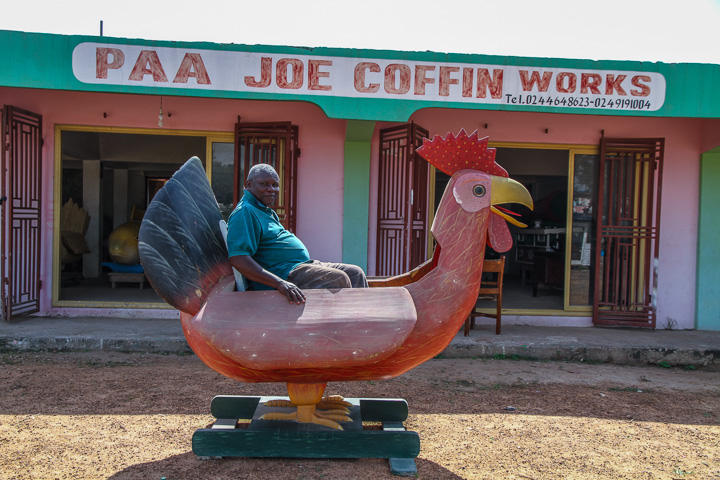Joseph Tetteh-Ashong, also known as Paa Joe is a Ghanaian figurative palanquin and fantasy coffin artist born in 1947 at Akwapim in the Eastern Region of Ghana.
Paa Joe is considered one of the most important Ghanaian coffin or abebuu adekai (“proverb boxes”) artists of his time.
He has been involved in the international art world since 1989 and has been included in major exhibitions in Europe, Japan, and the USA.
His fantasy coffins are in the collections of many art museums worldwide, including the British Museum in London, the Brooklyn Museum in New York, and the National Museum of Ethnology in Osaka as well as the private collections of foreign dignitaries.
Paa Joe began his career with a twelve-year apprenticeship as a coffin artist in the workshop of Kane Kwei (1924–1992) in Teshie.
In 1976, Paa Joe started his own business in Nungua. He trained many young artists like Daniel Mensah, Eric Kpakpo, or Kudjoe Affutu who have also become very successful fantasy coffin artists.
Fantasy coffins
While the pieces crafted by Paa Joe are real coffins that the deceased are buried in, the process to obtain a figurative coffin is very different from the normal process one might go about to obtain a coffin for themselves or a loved one. Each piece is a custom commission that has relevance to the deceased’s life.
Figurative coffins have great cultural significance in Ghana. While the practice of making Figurative coffins was debatably started by Paa Joe’s instructor, Kane Kwei, the concept has deep roots in Ga tradition.
Figurative coffins have been around since the 1950s. However, figurative palanquins have a much deeper history in Ghana.
Workshop/process
Paa Joe crafts his coffins in his workshop in Accra, Ghana. His workshop comprises a few main areas including an office, a showroom, a preparation room for painting and shipping, and a tool storage area. However, much of the actual Coffin Construction is performed behind the workshop under the shade of trees.
Works
Some of his works which were in the shape of Porsches, naked women, Nike trainers, cameras, Coca-Cola bottle, and chili pepper are designed to represent the life of the deceased, with each item handcrafted and painted for the funeral procession, which can last up to three days and three nights.
In the tradition of figurative coffins or abeduu adekai (which means “proverb boxes”) the structures represent the unique lives of the dead.
This exhibition comprises a series of large-scale, painted wood sculptures commissioned in 2004 and 2005 that represent architectural models of Gold Coast castles and forts, which served as way stations for more than six million Africans sold into slavery and sent to the Americas and the Caribbean between the sixteenth and nineteenth centuries.
Once they were forced through the “Gates of No Return,” these enslaved people started an irreversible and perilous journey during which many died.
Relying on traditional techniques and materials, Joe crafts his sculptures to represent vessels ferrying the dead into the afterlife that speaks to spirits separated from bodies in trauma.
Source: high.org/exhibition
